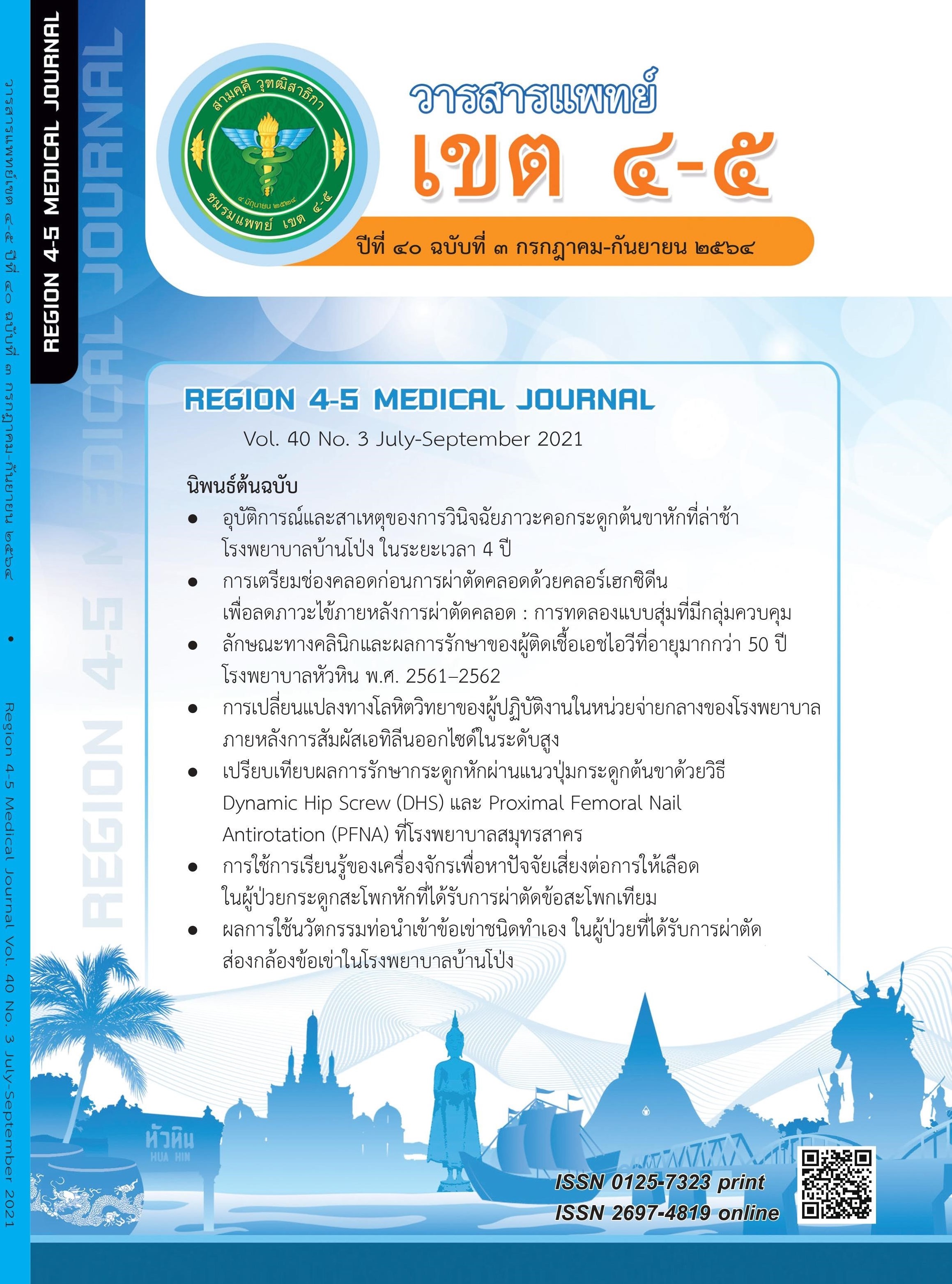ประสิทธิภาพของออกซิโทซินร่วมกับไมโซพรอสทอล และออกซิโทซินอย่างเดียว ในการลดการเสียเลือดภายหลังการคลอดทางช่องคลอด : การทดลองแบบสุ่มที่มีกลุ่มควบคุม
คำสำคัญ:
ภาวะตกเลือดหลังคลอดิ, ไมโซพรอสทอลบทคัดย่อ
วัตถุประสงค์: เพื่อศึกษาประสิทธิภาพของไมโซพรอสทอล ในการลดการสูญเสียเลือดภายหลังการคลอดปกติทางช่องคลอด และผลข้างเคียงของไมโซพรอสทอล
วิธีการศึกษา: การทดลองนี้เป็นการทดลองแบบสุ่มที่มีกลุ่มควบคุม ที่โรงพยาบาลนครปฐม ตั้งแต่เดือนมกราคม ถึงเดือนมิถุนายน พ.ศ. 2564 โดยทำการศึกษาในสตรีที่คลอดปกติทางช่องคลอดจำนวน 200 ราย ทำการสุ่มเปรียบเทียบ 2 กลุ่มแบบง่าย กลุ่มละ 100 ราย กลุ่มศึกษา หลังคลอดจะได้รับออกซิโทซินร่วมกับไมโซพรอสทอล เหน็บทางทวารหนัก ส่วนกลุ่มควบคุม จะได้รับออกซิโทซินอย่างเดียว
ผลการศึกษา: กลุ่มศึกษา ที่ได้รับออกซิโทซินร่วมกับไมโซพรอสทอล มีปริมาณการเสียเลือดหลังคลอดเฉลี่ย 218.65±118.92 มิลลิลิตร ส่วนในกลุ่มควบคุมมีปริมาณการเสียเลือดหลังคลอดเฉลี่ย 292.00±199.34 มิลลิลิตร ซึ่งมีความแตกต่างกันอย่างมีนัยสำคัญทางสถิติ (p-value = .005) ในกลุ่มศึกษาพบว่าฮีมาโตคริต ลดลงเฉลี่ยร้อยละ 1.50±2.21 ส่วนกลุ่มควบคุม ฮีมาโตคริต ลดลงเฉลี่ยร้อยละ 2.66±2.70 ซึ่งมีความแตกต่างกันอย่างมีนัยสำคัญทางสถิติ (p-value = .015) นอกจากนี้กลุ่มศึกษา มีอาการข้างเคียงของไมโซพรอสทอล คือ รู้สึกหนาวเล็กน้อย แต่ไม่มีอาการสั่น ส่วนกลุ่มควบคุม ไม่มีอาการข้างเคียงใดๆ
สรุป : ไมโซพรอสทอลเหน็บทางทวารหนัก เมื่อใช้ร่วมกับออกซิโทซิน มีผลช่วยลดปริมาณการเสียเลือดภายหลังการคลอดปกติ เมื่อเปรียบเทียบกับกลุ่มที่ได้รับออกซิโทซินอย่างเดียว และกลุ่มศึกษา ที่ได้รับไมโซพรอสทอล มีอาการข้างเคียงเพียงเล็กน้อย
เอกสารอ้างอิง
2. AbouZahr C. Global burden of maternal death and disability. Br Med Bull 2003;67: 1– 11.
3. Prapawichar P, Ratinthorn A, Utriyaprasit K, et al. Maternal and health service predictors of postpartum hemorrhage across 14 district, general and regional hospitals in Thailand. BMC Pregnancy Childbirth 2020;20:172.
4. Carroli G, Cuesta C, Abalos E, et al. Epidemiology of postpartum hemorrhage: a systematic review. Best Pract Res Clin Obstet Gynaecol 2008;22:999–1012.
5. Combs CA, Murphy EL, Laros RK. Factors associated with postpartum haemorrhage with vaginal birth. Obstet Gynecol 1991;77: 69– 76.
6. Sheiner E, Sarid L, Levy A, et al. Obstetric risk factors and outcome of pregnancies complicated with early postpartum haemorrhage: a population‐based study. J Matern Fetal Neonatal Med 2005;18:149– 54.
7. Mousa H, Walkinshaw S. Major postpartum haemorrhage. Curr Opin Obstet Gynecol 2001;13: 595– 603.
8. Acharya G, Al-Sammarai MT, Patel N, et al. A randomized, controlled trial comparing effect of oral misoprostol and intravenous syntocinon on intra-operative blood loss during cesarean section. Acta Obstet Gynecol Scand 2001;80:245-50.
9. Dansereau J, Joshi AK, Helewa ME, et al. Double-blind comparison of carbetocin versus oxytocin in prevention of uterine atony after cesarean section. Am J Obstet Gynecol 1999;180:670-6.
10. Munn MB, Owen J, Vincent R, et al. Comparison of two oxytocin regimens to prevent uterine atony at cesarean delivery: a randomized controlled trial. Obstet Gynecol 2001;98:386-90.
11. Khan RU, El-Refaey H. Pharmacokinetics and adverse-effect profile of rectally administered misoprostol in the third stage of labor. Obstet Gynecol 2003;101(5 P):968–74.
12. Khan RU, El-Refaey H, Sharma S, et al. Oral, Rectal, and Vaginal Pharmacokinetics Obstet Gyn. 2004;103(5):866–70.
13. Pakniat H, Khezri MB. The effect of combined oxytocin–misoprostol versus oxytocin and misoprostol alone in reducing blood loss at cesarean delivery: a prospective randomized double-blind study. J Obstet Gynecol India 2015;65(6):376–81.
14. Morfaw F, Fundoh M, Pisoh C, et al. Misoprostol as an adjunct to oxytocin can reduce postpartum-haemorrhage: A propensity score-matched retrospective chart review in Bamenda-Cameroon, 2015–2016. BMC Pregnancy Childbirth 2019;19: 257.
15. Fawole AO, Sotiloye OS, Hunyinbo KI, et al. A double-blind, randomized, placebo-controlled trial of misoprostol and routine uterotonics for the prevention of postpartum hemorrhage. Int J Gynaecol Obstet 2011;112(2):107–11.
16. Hofmeyr GJ, Fawole B, Mugerwa K, et al. Administration of 400 mug of misoprostol to augment routine active management of the third stage of labor. Int J Gynaecol Obstet. 2011;112(2):98–102.
17. Parsons SM, Walley RL, Crane JM, et al. Rectal misoprostol versus oxytocin in the management of the third stage of labour. J. Obstet. Gynaecol. Can. 2007; 29: 711-18.
ดาวน์โหลด
เผยแพร่แล้ว
รูปแบบการอ้างอิง
ฉบับ
ประเภทบทความ
สัญญาอนุญาต
ลิขสิทธิ์บทความเป็นของผู้เขียนบทความ แต่หากผลงานของท่านได้รับการพิจารณาตีพิมพ์ลงวารสารแพทย์เขต 4-5 จะคงไว้ซึ่งสิทธิ์ในการตีพิมพ์ครั้งแรกด้วยเหตุที่บทความจะปรากฎในวารสารที่เข้าถึงได้ จึงอนุญาตให้นำบทความในวารสารไปใช้ประโยชน์ได้ในเชิงวิชาการโดยจำเป็นต้องมีการอ้างอิงถึงชื่อวารสารอย่างถูกต้อง แต่ไม่อนุญาตให้นำไปใช้ในเชิงพาณิชย์




